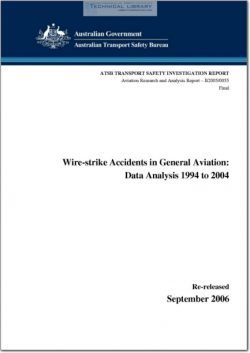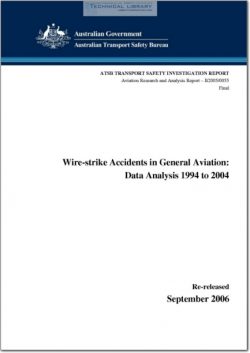ATSB-B2005-0055

- Version
- 176 Downloads
- 1.47 MB File Size
- 1 File Count
- August 9, 2016 Create Date
- August 9, 2016 Last Updated
Wirestrike Accidents in General Aviation; Data Analysis 1994 to 2004

The aim of this study was to provide an analysis of wire-strike accidents and
incidents. This should increase knowledge and insight in the Australian aviation
community and improve safety in low—level flight.
A search of the Australian Transport Safety Bureau’s accident and incident
database identified 119 wire-strike accidents and 98 wire-strike incidents between
1994 and 2004. The rate of wire—strike accidents per 100,000 hours flown ranged
from around 0.9 in 1997 and 1998 to 0.1 in 2003. The figures suggested a
downward trend from 1998 to 2003, but in 2004 the rate increased to 0.7.
There were 169 people involved in the 119 wire—strike accidents reported between
1994 and 2004. In almost two—thirds of these accidents the occupant received some
degree of injury. There were 45 people fatally injured, 22 seriously injured, and 42
who received minor injuries.
Reported wire—strike accidents and incidents were restricted to general aviation
operations, primarily in three of the statistical groups used by the Australian
Transport Safety Bureau for investigative purposes — aerial agriculture operations,
other aerial work1 , and private/business operations. The majority of wire—strike
accidents involved aerial agriculture operations, accounting for 74 accidents or 62
per cent. Other aerial work operations recorded the second highest number of wire-
strike accidents with 24 accidents (20 per cent), followed by private/business
operations, which accounted for 18 accidents (15 per cent). One accident was
recorded in the charter category and two were recorded in the flying training
category.
Fixed-wing aircraft were involved in 57 per cent of wire—strike accidents and rotary—
wing aircraft were involved in 43 per cent. Given that fixed-wing aircraft out
number rotary—wing aircraft by seven to one in the Australian aviation industry,
rotary—wing aircraft were over—represented in the data. This imbalance may reflect
the different nature of work undertaken by these two types of aircraft, with rotary-
wing operations involving a higher level of risk in relation to wire strikes. In the
absence of specific data on low-level operations, analysis of risk exposure levels for
fixed-wing and rotary—wing operations was not possible.
| File | Action |
|---|---|
| ATSB-B2005-0055 Wirestrike Accidents in General Aviation; Data Analysis 1994 to 2004.pdf | Download |

Comment On This Post